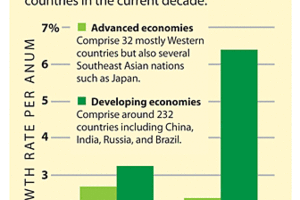Amid economic slowdown, signs of new world order
Emerging markets are helping buoy global growth.

SOURCE: International Monetary Fund and Wachovia Corporation /Rich Clabaugh–STAFF
The world economy is cooling this year thanks to a slowdown in the United States, but something new is playing out: This slowdown is serving to amplify a shift in financial power toward Asia and developing nations.
Countries such as China and India are now big enough to help guide the global economy. In the past, a sharp downshift in the US and Europe would decisively slow the rate of global growth.
This time, emerging markets appear poised to grow collectively by 6.7 percent this year, according to recent forecasts by the International Monetary Fund. As a result, the IMF sees world gross domestic product (GDP) growing 3.7 percent, even though the US might experience a recession.
The US economy remains the world's mightiest. But even for Americans, this new economic order has immediate implications:
•Policymakers at the Federal Reserve must worry about upward price pressures for food and fuel – driven largely by rising demand in developing nations. That problem calls for tighter monetary policy, while the domestic consumer slump calls for the opposite policy.
•Demand for US exports from these new markets is providing a helpful cushion for growth, yet trade tensions could be an issue in the US presidential election.
•Money from emerging markets is playing an increasingly important role in the US financial system.
"We have a new pecking order in the world economy in terms of influence on global growth and economic power," says Michael Cosgrove, an economist in Dallas. "[Historically] we would see oil prices fall with a slowdown in the US and Europe…. That no longer holds."
The dynamism of the "BRIC" bloc – Brazil, Russia, India, and China – is not new, but their stunningly rapid rise in this past decade is now being tested in the laboratory of tough times.
For consumers and workers worldwide, what's playing out is a tug of war between two opposing problems.
First is the weakness in the US and some other advanced nations as a housing slump and related credit squeeze hits households. That's dragging GDP growth down on all continents.
Second is inflation, a symptom of the strength of emerging nations. Their demand for commodities explains much of the surge in fuel and food prices worldwide. It's this problem that is, at present, taking center stage as a global worry.
"The good news here is that the standard of living for a lot of people is improving," says Mr. Cosgrove, publisher of the EconoClast newsletter. But for now, "the bad news is that it pushes up prices."
What's changed in the world economy is not just the rate of growth of countries labeled developing or emerging. It's also the size of their economic output.
"What's different this time is that the emerging market economies have been growing so rapidly that they've emerged," says Ed Yardeni, an economic forecaster at Yardeni Research in Great Neck, N.Y. "They've become very large."
Now, these nations are accounting for more than half the world's economic growth in a given year. And, when measured in terms of the domestic purchasing power of their incomes, these countries are also approaching half of global economic output, according to IMF figures.
This makes it a different world from just seven years ago, the last time the US was in a recession. Then, America's nosedive brought global GDP growth down to 2.2 percent in 2001. Considering the expectation that GDP should keep pace with population growth, that was in effect a worldwide recession.
Oil prices were not a concern then. But growth in developing nations fell sharply to 3.8 percent from 5.9 percent in 2000.
This year, by contrast, the IMF forecasts a recession in the US but growth well above 6 percent in developing countries – down just a percentage point from last year.
Recession or not, how the American economy fares depends partly on trends in emerging markets.
One issue is cash supply. Historically, emerging economies are importers of capital. Now, "sovereign wealth funds," investment funds controlled by developing nation governments are helping US banks survive mortgage-related losses. More broadly, nearly half of US capital inflows over the past year and a quarter came from China, Brazil, Mexico, and Russia, according to Bank of America.
Emerging economies are also influencing monetary policy. The Federal Reserve has been lowering interest rates to stave off a banking crisis. But rising commodity prices mean the Fed has to be ready to fight inflation with higher interest rates.
Economists at Merrill Lynch predict that the current global economic cycle hinges on when monetary authorities in creditor nations – many in the developing world – clamp down on inflation.
Other economists caution against viewing emerging economies as being in the driver's seat. "The US is still the biggest by far," says Jay Bryson of Wachovia Corp in Charlotte, N.C.
He predicts that inflation pressures will abate as the world feels the cooling effect of the slowdown in US and Europe.
Developing nations are also trading more than ever, offsetting the US slowdown. But these trade ties are also controversial, especially with China.
A backlash against trade with developing nations is possible in the aftermath of the US election this fall.
It's a thorny political question – how to deal with policies that may not help every worker or that help some nations more than others. "Before, say, 1985, the United States got the majority of the gains from trade" with other nations, says Cosgrove. Since then, he reckons, "the US has a smaller share of the gains from trade."
Trade remains helpful for America and the world, but the danger is that voter psychology is shifting, he says.
